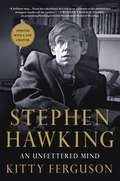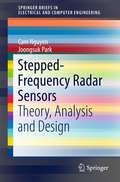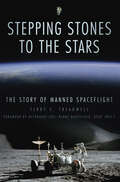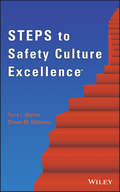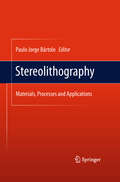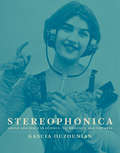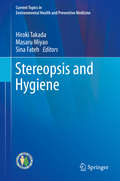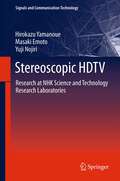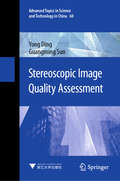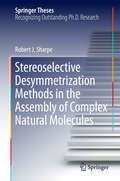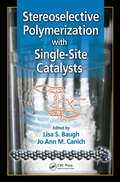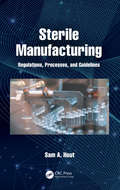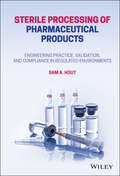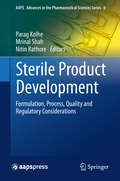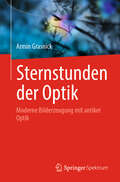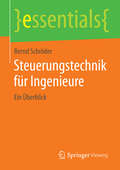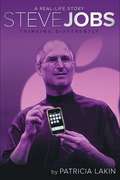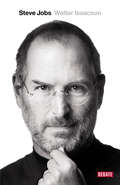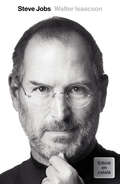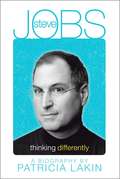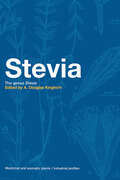- Table View
- List View
Stephen Hawking: An Unfettered Mind (Ciencia Y Tecnología Ser.)
by Kitty FergusonKitty Ferguson, the award-winning and international bestselling author of Stephen Hawking’s biography, presents an even deeper portrait of the legendary physicist’s life and scientific theories.This updated edition of Stephen Hawking: An Unfettered Mind looks at one of the most remarkable figures of our age: the bestselling author of A Brief History of Time, celebrated theoretical physicist, and an inspiration to millions around the world. Ferguson offers fresh insights into the way Hawking thinks and works, his ever-more-imaginative adventures in science at the “flaming ramparts of the world,” the discovery of gravity waves, the blockbuster proposal for “Starshot” to explore the cosmos, and his powerful use of his celebrity on behalf of human rights and survival on earth and beyond.With rare access to Hawking, including childhood photos and in-depth research, Ferguson creates a rich and comprehensive picture of his life: his childhood; the heartbreaking ALS diagnosis when he was a first-year graduate student; his long personal battle for survival in pursuit of a scientific understanding of the universe; and his rise to international fame. She also uses her gift for translating the language of theoretical physics into the language of the rest of us to make Hawking’s scientific work accessible.This is an insightful, absorbing, and definitive account of a brilliant mind and the extraordinary life of a man who always looks towards tomorrow.
Stepped-Frequency Radar Sensors
by Cam Nguyen Joongsuk ParkThis book presents the theory, analysis and design of microwave stepped-frequency radar sensors. Stepped-frequency radar sensors are attractive for various sensing applications that require fine resolution. The book consists of five chapters. The first chapter describes the fundamentals of radar sensors including applications followed by a review of ultra-wideband pulsed, frequency-modulated continuous-wave (FMCW), and stepped-frequency radar sensors. The second chapter discusses a general analysis of radar sensors including wave propagation in media and scattering on targets, as well as the radar equation. The third chapter addresses the analysis of stepped-frequency radar sensors including their principles and design parameters. Chapter 4 presents the development of two stepped-frequency radar sensors at microwave and millimeter-wave frequencies based on microwave integrated circuits (MICs), microwave monolithic integrated circuits (MMICs) and printed-circuit antennas, and discusses their signal processing. Chapter 5 provides the electrical characterization and test results of the developed microwave and millimeter-wave stepped-frequency radar sensors. Finally, a summary and conclusion is provided.
Stepping Stones to the Stars: The Story of Manned Spaceflight
by Terry C Treadwell Henry HartsfieldStepping Stones to the Stars is the story of manned spaceflight from its inception to the era of the Space Shuttle. It begins with a short history of the evolution of the rocket, before describing the first manned rocket flights by both the Americans and the Russians. There is also the little-known story of what is thought to be the earliest manned rocket flight, said to have taken place in 1933 on the island of Rgen in the Baltic under the control of the German War Ministry. The story continues through Yuri Gagarin becoming the first person in space and Neil Armstrong's giant leap for mankind; to the first space stations, Skylab, Salyut and Mir.With the development of the Shuttle, the USA moved ahead in the space race, but the Americans and Russians soon realised that it was easier to co-operate than compete, and the two nations began to work together for the first time. Terry C. Treadwell's book is a non-technical history of human spaceflight, that tells the exciting and dramatic story of how we took our early steps towards the stars.
Steps to Safety Culture Excellence
by Terry L. Mathis Shawn M. GallowayProvides a clear road map to instilling a culture of safety excellence in any organizationDid you know that accidental injury is among the top ten leading causes of death in every age group? With this book as your guide, you'll learn how to help your organization develop, implement, and sustain Safety Culture Excellence, vital for the protection of and improvement in the quality of life for everyone who works there.STEPS to Safety Culture Excellence is based on the authors' firsthand experience working with international organizations in every major industry that have successfully developed and implemented ongoing cultures of safety excellence. Whether your organization is a small regional firm or a large multinational corporation, you'll find that the STEPS process enables you to instill Safety Culture Excellence within your organization.STEPS (Strategic Targets for Excellent Performance in Safety) demystifies the process of developing Safety Culture Excellence by breaking it down into small logical, internally led tasks. You'll be guided through a sequence of STEPS that makes it possible to:Create a culture of excellence that is reinforced and empowered at every levelDevelop the capability within the culture to identify, prioritize, and solve safety problems and challengesMaintain and continuously improve the performance of your organization's safety cultureAlthough this book is dedicated to safety, the tested and proven STEPS process can be used to promote excellence in any aspect of organizational performance.By optimizing the safety culture in your organization, you will give the people you work with the skills and knowledge to not only minimize the risk of an on-the-job accident, but also to lead safe, healthy lives outside of work.
Stereolithography
by Paulo Jorge BártoloStereolithography: Materials, Processes and Applications will focus on recent advances in stereolithography covering aspects related to the most recent advances in the field, in terms of fabrication processes (two-photon polymerization, micro-stereolithography, infrared stereolithography and stereo-thermal-lithography), materials (novel resins, hydrogels for medical applications and highly reinforced resins with ceramics and metals), computer simulation and applications.
Stereophonica: Sound and Space in Science, Technology, and the Arts
by Gascia OuzounianEpisodes in the transformation of our understanding of sound and space, from binaural listening in the nineteenth century to contemporary sound art.The relationship between sound and space has become central to both creative practices in music and sound art and contemporary scholarship on sound. Entire subfields have emerged in connection to the spatial aspects of sound, from spatial audio and sound installation to acoustic ecology and soundscape studies. But how did our understanding of sound become spatial? In Stereophonica, Gascia Ouzounian examines a series of historical episodes that transformed ideas of sound and space, from the advent of stereo technologies in the nineteenth century to visual representations of sonic environments today.Developing a uniquely interdisciplinary perspective, Ouzounian draws on both the history of science and technology and the history of music and sound art. She investigates the binaural apparatus that allowed nineteenth-century listeners to observe sound in three dimensions; examines the development of military technologies for sound location during World War I; revisits experiments in stereo sound at Bell Telephone Laboratories in the 1930s; and considers the creation of "optimized acoustical environments" for theaters and factories. She explores the development of multichannel "spatial music" in the 1950s and sound installation art in the 1960s; analyzes the mapping of soundscapes; and investigates contemporary approaches to sonic urbanism, sonic practices that reimagine urban environments through sound.Rich in detail but accessible and engaging, and generously illustrated with photographs, drawings, maps, and diagrams of devices and artworks, Stereophonica brings an acute, imaginative, and much-needed historical sensibility to the growing literature around sound and space.
Stereopsis and Hygiene (Current Topics in Environmental Health and Preventive Medicine)
by Hiroki Takada Masaru Miyao Sina FatehThis book outlines the principle and display methods of stereopsis, the biological effects of image viewing, and the effects on the human body, as well as its clinical significance. The authors also present the latest research findings and future prospects for stereopsis methods. In the field of medical care, the technique is useful for the 3-dimensional identification of lesions and affected regions; however, stereoscopic images can cause unpleasant symptoms including motion sickness, headache, and visual fatigue. With increasing opportunities for using the stereoscopic viewing technique in various other fields outside medicine, it is important to resolve the underlying issues of stereoscopic viewing and improve the diagnostic accuracy, safety of surgery and reduce the stress for physicians. Written by pioneering authors, Cutting Edge in Information Displays and Hygiene is a valuable resource for both new and established researchers and students seeking comprehensive information on stereoscopic imaging methods as well as professionals working in environmental/occupational health and health promotion.
Stereoscopic HDTV
by Hirokazu Yamanoue Masaki Emoto Yuji NojiriThis book focuses on the two psychological factors of naturalness and ease of viewing of three-dimensional high-definition television (3D HDTV) images. It has been said that distortions peculiar to stereoscopic images, such as the "puppet theater" effect or the "cardboard" effect, spoil the sense of presence. Whereas many earlier studies have focused on geometrical calculations about these distortions, this book instead describes the relationship between the naturalness of reproduced 3D HDTV images and the nonlinearity of depthwise reproduction. The ease of viewing of each scene is regarded as one of the causal factors of visual fatigue. Many of the earlier studies have been concerned with the accurate extraction of local parallax; however, this book describes the typical spatiotemporal distribution of parallax in 3D images. The purpose of the book is to examine the correlations between the psychological factors and amount of characteristics of parallax distribution in order to understand the characteristics of easy- and difficult-to-view images and then to seek to create a new 3D HDTV system that minimizes visual fatigue for the viewer. The book is an important resource for researchers who wish to investigate and better understand various psychological effects caused by stereoscopic images.
Stereoscopic Image Quality Assessment (Advanced Topics in Science and Technology in China #60)
by Yong Ding Guangming SunThis book provides a comprehensive review of all aspects relating to visual quality assessment for stereoscopic images, including statistical mathematics, stereo vision and deep learning. It covers the fundamentals of stereoscopic image quality assessment (SIQA), the relevant engineering problems and research significance, and also offers an overview of the significant advances in visual quality assessment for stereoscopic images, discussing and analyzing the current state-of-the-art in SIQA algorithms, the latest challenges and research directions as well as novel models and paradigms. In addition, a large number of vivid figures and formulas help readers gain a deeper understanding of the foundation and new applications of objective stereoscopic image quality assessment technologies.Reviewing the latest advances, challenges and trends in stereoscopic image quality assessment, this book is a valuable resource for researchers, engineers and graduate students working in related fields, including imaging, displaying and image processing, especially those interested in SIQA research.
Stereoselective Desymmetrization Methods in the Assembly of Complex Natural Molecules
by Robert. J SharpeThis thesis describes the inception, design, and implementation of stereoselective desymmetrization reactions in the total synthesis of the natural products pactamycin and paspaline. In the case of pactamycin, the author develops a novel asymmetric Mannich reaction and symmetry-breaking reduction strategy to enable facile construction of the complex core architecture in fifteen steps using commercially available materials - the shortest synthesis to date. He subsequently demonstrates the flexibility of this approach in SAR investigations by highlighting the preparation of twenty-five unique pactamycin structural congeners. For paspaline, the author develops a biocatalytic desymmetrization strategy that allows the highly controlled synthesis of core stereochemistry and provides a platform for the development of new conceptual disconnections in the synthesis of "steroid-like" natural products. This thesis offers a valuable resource for students embarking on a PhD in total synthesis.
Stereoselective Polymerization with Single-Site Catalysts
by Lisa S. Baugh Jo Ann M. CanichNew synthetic techniques allow chemists to modify polymer microstructures more precisely than ever, making it possible to design materials that meet increasingly demanding performance requirements. Written and edited by experts in the field, Stereoselective Polymerization with Single-Site Catalysts reviews how the relative stereochemistry of
Sterile Manufacturing: Regulations, Processes, and Guidelines
by Sam A. HoutThis book highlights key ideas and factors to coach and guide professionals involved in learning about Sterile Manufacturing and operational requirements. It covers regulations and guidelines instituted by the FDA, ISPE, EMA, MHRA, and ICH, emphasizing good manufacturing practice and inspection requirements in the manufacturing of medicinal products. Additionally, this book provides the fundamentals of aseptic techniques, quality by design, risk assessment, and management in support of sterile operations applications. It creates a link to the implementation of business practices in drug manufacturing and healthcare and forms a correlation between design strategies including a step-by-step process to ensure reliability, safety, and efficacy of healthcare products for human and animal use. The book also provides a connection between drug production and regulated applications by offering a review of the basic elements of sterile processing, and how to remain viable with solid strategic planning. The book is a concise reference for professionals and learners in the field of sterile operations that governs primarily, pharmaceutical and medical device space, but can also extend to food and cosmetics that require clean (aseptic) manufacturing applications. It also helps compounding pharmacists and GMP inspectors and auditors.
Sterile Processing of Pharmaceutical Products: Engineering Practice, Validation, and Compliance in Regulated Environments
by Sam A. HoutDescribes the methodologies and best practices of the sterile manufacture of drug products Thoroughly trained personnel and carefully designed, operated, and maintained facilities and equipment are vital for the sterile manufacture of medicinal products using aseptic processing. Professionals in pharmaceutical and biopharmaceutical manufacturing facilities must have a clear understanding of current good manufacturing practice (cGMP) and preapproval inspection (PAI) requirements. Sterile Processing of Pharmaceutical Products: Engineering Practice, Validation, and Compliance in Regulated Environments provides up-to-date coverage of aseptic processing techniques and sterilization methods. Written by a recognized expert with more than 20 years of industry experience in aseptic manufacturing, this practical resource illustrates a comprehensive approach to sterile manufacturing engineering that can achieve drug manufacturing objectives and goals. Topics include sanitary piping and equipment, cleaning and manufacturing process validation, computerized automated systems, personal protective equipment (PPE), clean-in-place (CIP) systems, barriers and isolators, and guidelines for statistical procedure. Offering authoritative guidance on the key aspects of sterile manufacturing engineering, this volume: Covers fundamentals of aseptic techniques, quality by design, risk assessment and management, and operational requirements Addresses various regulations and guidelines instituted by the FDA, ISPE, EMA, MHRA, and ICH Provides techniques for systematic process optimization and good manufacturing practice Emphasizes the importance of attention to detail in process development and validation Features real-world examples highlighting different aspects of drug manufacturing Sterile Processing of Pharmaceutical Products: Engineering Practice, Validation, and Compliance in Regulated Environments is an indispensable reference and guide for all chemists, chemical engineers, pharmaceutical professionals and engineers, and other professionals working in pharmaceutical sciences and manufacturing.
Sterile Product Development
by Parag Kolhe Mrinal Shah Nitin RathoreThis comprehensive book encompasses various facets of sterile product development. Key concepts relevant to the successful development of sterile products are illustrated through case studies and are covered under three sections in this book: * Formulation approaches that discuss a variety of dosage forms including protein therapeutics, lipid-based controlled delivery systems, PEGylated biotherapeutics, nasal dosage form, and vaccines * Process, container closure and delivery considerations including freeze-thaw process challenges, best practices for technology transfer to enable commercial product development, innovations and advancement in aseptic fill-finish operations, approaches to manufacturing lyophilized parenteral products, pen / auto-injector delivery devices, and associated container closure integrity testing hurdles for sterile product closures * Regulatory and quality aspects in the areas of particulate matter and appearance evaluation, sterile filtration, admixture compatibility considerations, sterilization process considerations, microbial contamination investigations and validation of rapid microbiological methods, and dry and moist heat sterilizers This book is a useful resource to scientists and researchers in both industry and academia, and it gives process and product development engineers insight into current industry practices and evolving regulatory expectations for sterile product development.
Sternstunden der Optik: Moderne Bilderzeugung mit antiker Optik
by Armin GrasnickIn diesem Buch werden historische Optiken auf deren Abbildungseigenschaften untersucht. Dabei soll die Frage beantwortet werden, ob man in der Antike schon das Konzept der Bildverarbeitung kannte. Die optische Abbildung geht seit jeher mit einer Veränderung bei der Darstellung der Objekte einher. Zumeist sind Farbfehler oder Verzerrungen des Bildes nur durch Unkenntnis oder Unvermögen der verursacht. Mitunter steckt aber auch die Absicht dahinter, mit der Optik das Bild so zu verändern, dass dadurch ein Erkenntnisgewinn verursacht oder der Nutzer getäuscht werden kann. Die historische Bildverarbeitung funktionierte noch völlig analog. Analog bedeutet hier aber keineswegs unmodern: Die optische Bildmanipulation erfolgt mit Lichtgeschwindigkeit, schneller als mit jedem Computer.
Steuerbares Reibverhalten trockenlaufender Tribosysteme (Mechanics and Adaptronics)
by Zhenwei MiaoDie vorliegende Arbeit untersucht einen neuen Freiheitsgrad zur Beeinflussung der Reibung, indem ein adaptiver Reibbelag entwickelt wird, dessen Reibung aktiv durch den Einsatz von den Piezoaktoren beeinflusst wird, und zwar primär durch Änderung bzw. Kombination verschiedener Materialpaarungen im Betrieb. Ein tribologisch gezielt beeinflussbares Reibsystem ermöglicht für einen breiteren Anwendungsbereich einen Betrieb mit geringer Reibleistung und geringem Verschleiß, indem die tribologischen Eigenschaften bzw. die Reibung bei Veränderungen der Betriebsbedingungen (z.B. Gleitgeschwindigkeit, Temperatur) durch eine Regelung angepasst werden. Bei trockenlaufenden Tribosystemen tritt für einige Reibmaterialien bei konstanter Normalkraft mit zunehmender Gleitgeschwindigkeit ein Abfall des Reibwertes auf. Dieser Abfall ist häufig unerwünscht, weil er beispielweise zu Reibschwingungen des Gesamtsystems oder zur Verringerung der Effektivität in Bremsen oder Kupplungen führen kann. Ein wesentliches Motiv dieses Vorhabens ist das Bestreben, den Reibwert des trockenlaufenden Reibbelages mit zunehmender Gleitgeschwindigkeit konstant zu halten oder ansteigen zu lassen, indem verschiedene unterschiedliche Reibmaterialien einzeln oder zusammen in Kontakt mit dem Gegenkörper gebracht werden. Reibbeläge mit adaptiven Komponenten, deren Eigenschaften gezielt verändert werden können, eröffnen ein breites Anwendungsspektrum in diversen Bereichen des Maschinenbaus.
Steuerungstechnik für Ingenieure: Ein Überblick (essentials)
by Bernd SchröderFür selbstarbeitende und automatisierte (Produktions-) Prozesse werden Steuerungstechniken genutzt. Die hierzu eingesetzten Elemente arbeiten mechanisch, pneumatisch, hydraulisch, elektrisch oder elektronisch. Ausführende Organe sind unter anderem Ventile, Pumpen, Motore, Schalter, Sensoren und Relais. Die hierfür gängigen Symbole werden vorgestellt und können in Schemata eingesetzt werden. Gelegentlich ist die Erstellung sequenzieller Schaltungen hilfreich. Für eine hohe Flexibilität bietet sich die speicherprogrammierbare Steuerung (SPS) an.
Steve Jobs
by Patricia LakinWritten especially for a young audience, a must-read biography of Steve Jobs: visionary, entrepreneur, inventor, and cofounder of Apple.Visionary. Pioneer. Little terror. Entrepreneur. Inventor. College dropout. Creative genius. These are just a few of the words used to describe the late Steve Jobs, cofounder, chairman, and chief executive officer of Apple Inc. Available in both paperback and hardcover, Patricia Lakin's biography for middle-grade readers tells the captivating and inspirational story of the 'Thomas Edison' of our time.
Steve Jobs
by Walter IsaacsonLa biografía definitiva de Steve Jobs, el fundador de Apple, escrita con su colaboración. La muerte de Steve Jobs ha conmocionado al mundo. Tras entrevistarlo en más de cuarenta ocasiones en los últimos dos años, además de a un centenar de personas de su entorno, familiares, amigos, adversarios y colegas, Walter Isaacson nos presenta la única biografía escrita con la colaboración de Jobs, el retrato definitivo de uno de los iconos indiscutibles de nuestro tiempo, la crónica de la agitada vida y abrasiva personalidad del genio cuya creatividad, energía y afán de perfeccionismo revolucionaron seis industrias: la informática, el cine de animación, la música, la telefonía, las tabletas y la edición digital. Consciente de que la mejor manera de crear valor en el siglo XXI es conectar la creatividad con la tecnología, Jobs fundó una empresa en la que impresionantes saltos de la imaginación van de la mano de asombrosos logros tecnológicos. Aunque Jobs colaboró en el libro, no pidió ningún control sobre el contenido, ni siquiera ejerció el derecho a leerlo antes de su publicación. No rehuyó ningún tema y animó a la gente que conocía a hablar con franqueza. «He hecho muchas cosas de las que no me siento orgulloso, como dejar a mi novia embarazada a los veintitrés años y cómo me comporté entonces, pero no hay ningún cadáver en mi armario que no pueda salir a la luz». Jobs habla con una sinceridad a veces brutal sobre la gente con la que ha trabajado y contra la que ha competido. De igual modo, sus amigos, rivales y colegas ofrecen una visión sin edulcorar de las pasiones, los demonios, el perfeccionismo, los deseos, el talento, los trucos y la obsesión por controlarlo todo que modelaron su visión empresarial y los innovadores productos que logró crear. Su historia, por tanto, está llena de enseñanzas sobre innovación, carácter, liderazgo y valores. La vida de un genio capaz de enfurecer y seducir a partes iguales. Reseña:«El fallecimiento de Steve Jobs ha precipitado un alud de libros sobre su figura. De todos ellos, la aproximación más completa e interesante al personaje es la de Isaacson.»La Vanguardia
Steve Jobs (edició en català)
by Walter IsaacsonLa biografia definitiva de Steve Jobs, creador d'Apple, escrita amb la seva total col·laboració. La mort de Steve Jobs ha commogut el món. Després de tenir-hi més de quaranta entrevistes en els darrers dos anys, i amb més d'un centenar de persones del seu entorn: familiars, amics, adversaris i col·legues, Walter Isaacson ens presenta l'única biografia escrita amb la col·laboració de Jobs, el retrat definitiu d'una de les icones indiscutibles del nostre temps, la crònica de l'agitada vida i la desgastant personalitat d'un geni que, amb la seva creativitat, energia i afany de perfeccionisme, va revolucionar sis indústries: la informàtica, el cine d'animació, la música, la telefonia, les tauletes i l'edició digital. Conscient que la millor manera de crear valor al segle XXI és connectar la creativitat amb la tecnologia, Jobs va fundar una empresa en la qual els impressionants salts de la imaginació van de bracet de sorprenents fitestecnològiques. Tot i que Jobs va col·laborar en el llibre, no va voler controlar el contingut, ni tan sols exercir el dret a llegir-lo abans de la publicació. No va defugir cap tema, i va encoratjar la gent que coneixia a parlar amb franquesa. «He fet moltes coses de les quals no em sento orgullós, com deixar la meva novia embarassada als vint-i-tres anys i la manera com em vaig comportar aleshores, però no hi ha cap cadàver al meu armari que no pugui sortir a la llum.» Jobs parla amb sinceritat, de vegades brutal, sobre la gent amb la qual ha treballat i contra la que ha competit. De la mateixa manera, els seus amics, rivals i col·legues ofereixen una visió gens ensucrada de les passions, els dimonis, el perfeccionisme, els desitjos, el talent, els trucs i l'obsessió per controlar-ho tot que varen modelar la seva visió empresarial i els innovadors productes que va aconseguir crear. La seva història, per tant, està plena d'ensenyaments sobre innovació, coratge, lideratge i valors. La vida d'un geni capaç d'enfurismar i de seduir a parts iguals.
Steve Jobs: A Biographic Portrait
by Kevin LynchThis is a stunning visual guide to the life and works of entrepreneur Steve Jobs. Easily one of the most influential innovators of the twenty-first century, Steve Jobs has fundamentally shaped the way in which we communicate and, even more broadly, live our lives. In this information-packed graphic biography, Steve Jobs&’ remarkable talent and genius are explored through bold design and original graphics. Kevin Lynch explores Jobs' journey from savvy salesman, to his rivalry and market competition with Bill Gates, and his shift towards radical innovations in later life. This technological innovator led a fascinating, astounding and ultimately too short life, that irreversibly impacted how we communicate. Steve Jobs is a visual celebration and comprehensive study of &‘The Maverick&’ and his work; and a must-have for any fan of Apple products.
Steve Jobs: Edicion en Español
by Walter IsaacsonLa muerte de Steve Jobs ha conmocionado al mundo. Tras entrevistarlo en más de cuarenta ocasiones en los últimos dos años, además de a un centenar de personas de su entorno, familiares, amigos, adversarios y colegas, Walter Isaacson nos presenta la única biografía escrita con la colaboración de Jobs, el retrato definitivo de uno de los iconos indiscutibles de nuestro tiempo, cuya creatividad, energía y afán de perfeccionismo revolucionaron seis industrias: la informática, el cine de animación, la música, la telefonía, las tabletas y la edición digital. Consciente de que la mejor manera de crear valor en el siglo xxi es conectar la creatividad con la tecnología, fundó una empresa en la que impresionantes saltos de la imaginación van de la mano de asombrosos logros tecnológicos. Aunque Jobs colaboró con el libro, no pidió ningún control sobre el contenido, ni siquiera el derecho a leerlo antes de la publicación. No rehuyó ningún tema y animó a la gente que conocía a hablar con franqueza. Jobs habla con sinceridad a veces brutal sobre la gente con la que ha trabajado y contra la que ha competido. De igual modo, sus amigos, rivales y colegas ofrecen una visión sin edulcorar de las pasiones, los demonios, el perfeccionismo, los deseos, el talento, los trucos y la obsesión por controlarlo todo que modelaron su visión empresarial y los innovadores productos que logró crear. Su historia, por tanto, es el retrato de una fascinante vida: la de un genio capaz de enfurecer y seducir a partes iguales.
Steve Jobs: Leader Strategist
by David B. Yoffie Cynthia A. Montgomery"In 2009, Fortune magazine published one of its many cover stories on Steve Jobs, this time naming him the CEO of the decade. Explaining why they chose to bestow this honor on Jobs, Stephanie Mehta argued that “No business figure has crushed it the way Jobs has these past 10 years. Even as the rest of business boomed and then crashed, he resuscitated Apple, which, many forget, was in horrific shape at the dawn of the decade, and simultaneously radically reinvented the music, movie, and telecommunications industries.”
Steve Jobs: Thinking Differently
by Patricia LakinWritten especially for a young audience, a must-read biography of Steve Jobs: visionary, entrepreneur, inventor, and cofounder of Apple. Visionary. Pioneer. Little terror. Entrepreneur. Inventor. College dropout. Creative genius. These are just a few of the words used to describe the late Steve Jobs, cofounder, chairman, and chief executive officer of Apple Inc.
Stevia: The Genus Stevia
by A. Douglas KinghornStevia rebaudiana is a remarkable South American plant that has become widely used in certain parts of the world as a natural sweetening agent and dietary supplement. Purified extracts of S. rebaudiana have been used as sweeteners and flavor enhancers in the food industry in Japan for over a quarter of a century, and have been found to be up to 300
